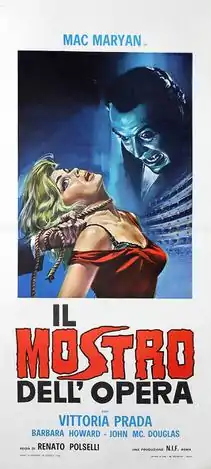The Vampire of the Opera
The Vampire of the Opera (Italian: Il mostro dell'opera; lit. 'The Monster of the Opera') is a 1964 Italian horror film co-written and directed by Renato Polselli and starring Marco Mariani and Giuseppe Addobbati.
| The Vampire of the Opera | |
|---|---|
 Italian film poster | |
| Directed by | Renato Polselli[1] |
| Screenplay by |
|
| Story by |
|
| Starring |
|
| Cinematography | Ugo Brunelli[1] |
| Edited by | Otello Colangeli[1] |
| Music by | Aldo Piga[1] |
Production company | Nord Inudstrial Film[1] |
| Distributed by | Nord Industrial |
Release date |
|
Running time | 85 minutes[1] |
| Country | Italy |
Plot
Cast
- Marco Mariani as Sandro
- Giuseppe Addobbati as Stefano
- Barbara Hawards as Giulia
- Alberto Archetti as Achille
- Carla Cavalli as Aurora
- Aldo Nicodemi as Aldo
- Jody Excell as Yvette
- Milena Vukotic as Carlotta
Production
The film had a very troubled production. Produced by Rossano Brazzi's brother, Oscar Brazzi, shooting started in 1961, but because of budget issues it was ended only in 1964.[1][2]
Initially conceived as a sequel of Polselli's 1960 horror film The Vampire and the Ballerina,[2] it had the working title "Il vampiro dell'opera" (lit. 'The Vampire of the Opera'), but because of the diminished interest of Italian audience in vampire films, when released it was eventually renamed, replacing the world vampire with monster ("mostro").[1]
Ernesto Gastaldi is credited as screenwriter, but according to him, he wrote only the treatment and made a few corrections to the script.[3][4] The film was shot in Narni.[1]
Release
The Vampire of the Opera was released in Italy on June 30, 1964 where it was distributed by Nord Industrial.[1]
Reception
In his book Italian Horror Film Directors, Louis Paul noted the similarities with Polselli's The Vampire and the Ballerina, both in "his fascination with full-bodied voluptuous actresses as well as the cheap and exploitative premise."[2] Similarly, Roberto Curti described the film as a variation on The Vampire and the Ballerina and on The Playgirls and the Vampire by Piero Regnoli, "i.e., a pretext for showing scantily clad young women, with a little hint of lesbianism to spice up the proceedings."[3][4]
References
Footnotes
- Curti 2015, p. 135.
- Paul 2005, p. 19.
- Curti 2015, p. 136.
- Curti 2015, p. 137.